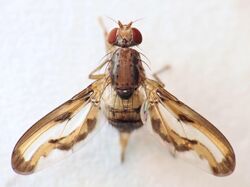Biology:Toxonevra muliebris
| Toxonevra muliebris | |
|---|---|

| |
| Scientific classification | |
| Domain: | Eukaryota |
| Kingdom: | Animalia |
| Phylum: | Arthropoda |
| Class: | Insecta |
| Order: | Diptera |
| Family: | Pallopteridae |
| Genus: | Toxonevra |
| Species: | T. muliebris
|
| Binomial name | |
| Toxonevra muliebris (Harris, 1780)[1]
| |
| Synonyms[2] | |
| |
Toxonevra muliebris is a species of flutter fly in the family Pallopteridae.[3][4] It has been found in Europe and North America. The pattern on the wings of this species is distinctive.
Taxonomy
This species was first described by Moses Harris under the name Musca muliebris.[5] Subsequently, this species has been included within the genus Palloptera.[5] It has also been known under the name Toxoneura muliebris.[3] However this name is regarded as being a misspelling of the genus Toxonevra.[4][6] It is currently known as Toxonevra muliebris.[3][7][2]
Description
Morris described this species as follows:
Measures two lines. The head, thorax, abdomen and legs, are of a pleasant pale brown. The wings are clear, having two broadish brown stripes from the apex to the shoulder, one of which lies along the sector edge, the other through the middle. This pretty fly is very scarce: it shakes its wings as it walks, like the Vibrans, and is not soon frightened away.[5]
The pattern on the wings of adults is distinctive and is a diagnostic feature when identifying this species.[6]
Distribution
This species is native to Europe,[3] and has been observed in countries such as Spain, Italy, Austria, France, Belgium, Great Britain and Ireland.[8] Recently it has been observed and collected in North America.[6]
Ecology
The larvae of this species have been found under tree bark and it has been hypothesised that they feed on beetle larvae. In North America adults of this species have also been discovered inside residential houses. It has been suggested that this is as a result of larvae of T. mulibris preferring to prey on the larvae of carpet beetles, a common household pest in North America.[6]
References
- ↑ Harris, M. (1780). An exposition of English insects. Decads III, IV. London: Robson Co.. pp. 73-99, 100-138, pls. 21-30, 31-40. https://www.biodiversitylibrary.org/item/226006#page/5/mode/1up. Retrieved 16 July 2021.
- ↑ 2.0 2.1 "Toxonevra muliebris". 29 June 2021. https://www.catalogueoflife.org/data/taxon/57M2R.
- ↑ 3.0 3.1 3.2 3.3 Evenhuis, Neal L.; Pape, Thomas (2 April 2021). "Toxonevra muliebris". Bishop Museum. http://www.diptera.org/Nomenclator/Details/224503.
- ↑ 4.0 4.1 Marshall, Stephen A. (2012). Flies: The Natural History & Diversity of Diptera. Firefly Books. ISBN 9781770851009. OCLC 1126641864.
- ↑ 5.0 5.1 5.2 , pp. 75, https://www.biodiversitylibrary.org/page/53457599, Wikidata Q107401818
- ↑ 6.0 6.1 6.2 6.3 Cannings, Robert A.; Gibson, Joel F., Wikidata Q107400802
- ↑ "Toxonevra muliebris (Harris, 1780)" (in en). https://www.gbif.org/species/1676600.
- ↑ Wallace, P. F; O'Connor, J. P. (31 July 1997). "Palloptera muliebris (Harris) (Dipt., Pallopteridae) discovered in Dublin City". Entomologist's Monthly Magazine 133: 114.
Wikidata ☰ Q14698364 entry
 |


